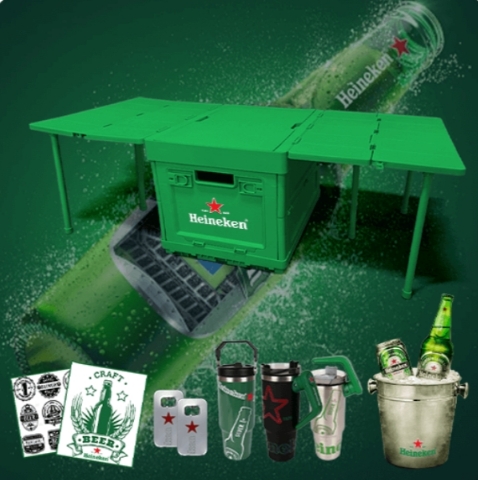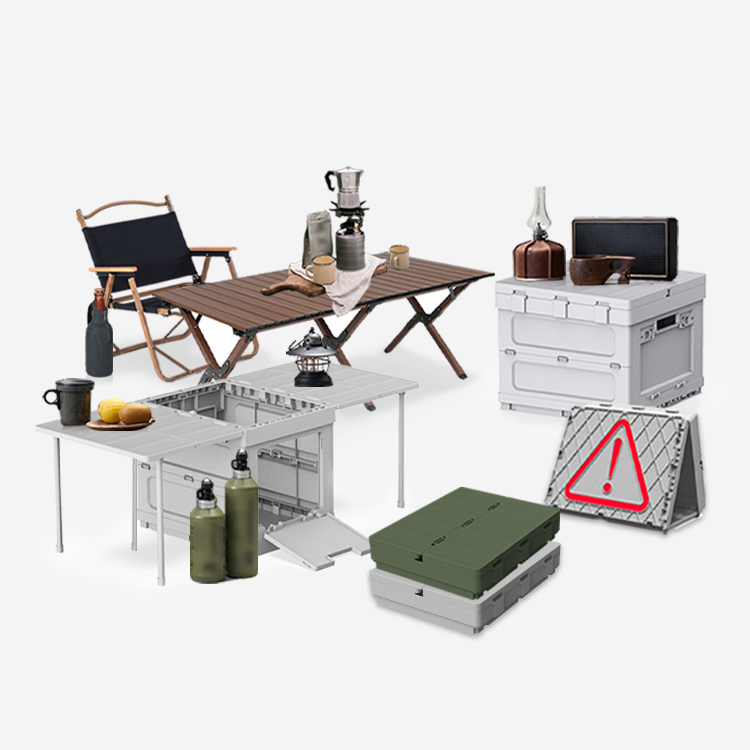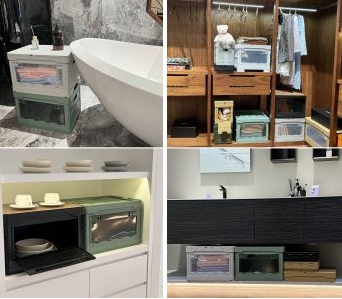Portable Camping Kitchens and Storage Tables: The Ultimate Camp Cooking Setup
Introduction
Having a well-organized and efficient camping kitchen setup can make all the difference in your outdoor adventures. Rather than rummaging through bags for a spatula or balancing a stove on the ground, a dedicated portable kitchen for camping provides a convenient space to prepare and cook meals while you’re away from home. It brings a bit of home comfort to the wilderness, keeping your cooking gear, ingredients, and utensils orderly and accessible. This not only makes camp cooking easier but also safer and more enjoyable for everyone.
Different types of campers can especially benefit from portable camp kitchens and storage tables. Beginners often appreciate the guidance of a structured setup—everything has its place, which makes cooking in camp less daunting. Families gain a central hub for meal prep that keeps sharp tools and flames safely away from kids (freeing up the picnic table for eating and games). Outdoor enthusiasts and intermediate campers love the efficiency—no more crouching or improvising a kitchen on uneven ground. Overlanders and long-term campers, in particular, rely on rugged camping storage box tables and chuck boxes that fit in vehicles, providing durable storage and an easy-to-deploy kitchen wherever they roam. In short, a good portable camp kitchen setup adds organization and convenience that can elevate the entire camping experience.
Key Features of Portable Camping Kitchens and Storage Tables
Modern camp kitchens and storage tables come packed with features to make outdoor cooking a breeze. Here are some key aspects to look for:
-
Portability: A portable camping kitchen should be foldable, lightweight, and easy to transport. Many designs collapse into a compact form—sometimes as slim as a few inches thick—making them easy to slide into your car trunk or truck bed. For example, one popular folding camp cook station features an X-shaped frame that allows the shelves and tabletop to be easily removed and folded down, fitting into a carry bag and weighing only about 21 lbs.
PP (polypropylene) is a preferred material for frames and countertops due to its exceptional durability, lightweight nature, and waterproof properties, ensuring resistance to outdoor elements. Unlike metal, PP won’t rust or corrode, making it ideal for long-term outdoor use. Look for designs with built-in carry handles or a suitcase-style fold that makes transportation effortless. Some all-in-one models even fold flat to just a few inches tall, further emphasizing their compact and travel-friendly design.

-
Portable kitchen for camping Storage Capacity: One big advantage of camp kitchen tables is the built-in storage. Many models feature drawers, shelves, or hanging organizers to stow your food and cooking gear. For instance, some folding kitchens include a fabric pantry with zippered compartments and shelves underneath the main table. These let you tuck away pots, pans, spices, and dry goods, protecting them from dust and bugs. Detachable storage bags or bins are also common – a design like the Camp Chef Sherpa Table comes with four removable zippered bags for utensils and ingredients (one even doubles as a sink or cooler with a waterproof lining). Having dedicated storage not only keeps your campsite tidy but also means less time digging for items and more time cooking. In essence, a good camping kitchen storage box table will have a place for everything, helping you stay organized in the wild.
-
Portable kitchen for camping Durability: Camping environments can be tough, so durability is key. Quality portable kitchens use robust materials like aluminum, steel, and weather-resistant plastics to ensure longevity. Aluminum alloy frames and powder-coated steel supports provide a stable structure that can hold heavy stoves and cookware without wobbling. For example, one sturdy camp kitchen has a powder-coated steel frame and heat-resistant aluminum countertop that can support a stove up to 48 lbs. Hard tabletops might be aluminum slats or MDF boards with a laminate, and windscreens are often aluminum or steel to handle high heat. Durable 600D polyester or PVC-coated fabrics are used for storage compartments, as they resist wear and moisture. High-end models even boast heavy-duty construction — some premium camp kitchens are built to withstand 300+ lbs on their tabletop and come with lifetime warranties. When choosing, look for quality touches like reinforced hinges, rust-proof hardware, and sturdy leg locks. A well-built camp kitchen will survive many seasons of camping.
-
Easy Setup and Space-Saving Design: Nobody wants to spend an hour setting up a kitchen after a long hike. Thankfully, most portable camping kitchens emphasize quick assembly. Many fold-out camp kitchens can be set up in under a minute – you just unfold the frame, snap on a countertop, and you’re done. One-piece designs are especially convenient: for instance, the GCI Slim-Fold Cook Station is a single folding unit that “sets up and folds down in record time” and even has an integrated carry handle for transport. Look for clever design features like telescoping legs (to adjust for uneven ground), and quick-locking hinges that secure everything in place. Space-saving is also crucial; good camp kitchens maximize workspace while minimizing bulk. Side tables and extensions provide extra prep area but fold away when not in use. Hooks, paper towel holders, and lantern poles often attach without adding bulk, giving you more functionality in the same footprint. In short, the best portable kitchens balance ample cooking space with a compact, collapsible form for convenience.
- A foldable portable camp kitchen table with an aluminum windscreen, side shelf, lower rack, and a fabric storage cabinet. This design highlights key features like a wind guard for the stove, organized storage space, and a lightweight frame for easy transport.
Choosing the Right Portable Kitchen for Camping
Not all camp cooks have the same needs, so it’s important to choose a portable kitchen that fits your style of camping and group size. Here are some considerations to guide your decision:
-
User Type and Camping Style: Think about who will use the kitchen and how. If you’re a beginner or weekend camper, you might prefer a simpler, budget-friendly setup that covers the basics without too much assembly. Families, on the other hand, often need larger kitchens with extra storage and workspace to prepare meals for multiple people. Overlanders or frequent campers may prioritize ruggedness and integration – for example, a camp kitchen that doubles as a storage box can be kept packed in the vehicle, ready to deploy at each stop. Consider whether you’ll mostly camp at established sites (where weight and size matter less) or if you need something more compact for remote or hike-in spots.
-
Size and Weight: The ideal dimensions of a camping kitchen depend on your group size and vehicle space. “Compact models are ideal for solo travelers or couples, while larger units are better suited for families or groups,” as one camping gear guide notes. If you camp alone or with one partner, a lightweight fold-up table with maybe one or two surfaces should suffice. But a family of five might need a bigger kitchen station with multiple countertops and a pantry. Pay attention to the packed size too—make sure the folded kitchen will fit in your car trunk alongside your other gear. Also check the weight; ultra-portable models can be under 20 lbs, whereas deluxe ones with extensive features might be 30 lbs or more. Ensure it’s something you can comfortably lift and carry a reasonable distance if needed.
-
Price vs. Performance: Portable camp kitchens come in a range of prices, so decide what fits your budget and expectations. There are budget-friendly options (often $50–$100) that provide a simple folding table with maybe a shelf or soft pantry—great for first-timers. Mid-range models (around $100–$200) tend to offer the best balance of price and features, giving you sturdier construction and extras like wind screens or extra storage without breaking the bank. Premium or high-end camp kitchens ($250 and up) will boast superior materials (like all-aluminum build or steel hinges), larger countertops, and goodies like built-in sinks or specialized storage. While you generally “get what you pay for,” beginners don’t necessarily need a top-of-the-line unit. However, if you camp often or in harsh conditions, investing in a durable, feature-rich kitchen can pay off in longevity and convenience.
-
Special Features: Make a note of any extra features that would enhance your camping style. For example, if you often camp in areas without picnic tables, having an integrated sink basin for washing dishes might be a huge plus (some portable kitchens include a collapsible sink or a basin liner in one of the storage bags). If you’re tall, an adjustable height table will save your back from hunching. Love cooking gourmet meals? Look for ample counter space and maybe an integrated spice rack or utensil hooks. If you frequently cook with a two-burner stove, ensure the kitchen has a dedicated stove platform and perhaps a windshield for it. For night cooking, a lantern pole attachment is invaluable (many kitchens include a telescoping lantern hook). Overlanders might seek designs that latch into vehicles or have modular add-ons (for example, slide-out kitchens or ones that attach to hitch racks). List out your “must-have” and “nice-to-have” features before choosing, so you can compare models against your needs.
Finally, always consider practicality: The best portable camp kitchen is one that you will actually bring with you. A slightly smaller, lighter kitchen that gets packed every time is better than a gigantic deluxe kitchen that stays at home because it’s too cumbersome. Aim for the sweet spot that matches your camping frequency, group size, and vehicle capacity.
Best Portable Camping Kitchens and Storage Tables: Recommendations
To help you narrow down the options, we’ve compiled a few top recommendations across different categories. Whether you’re looking for a premium camp kitchen or an affordable storage table, these examples highlight the best in each class:
High-End and Premium Camp Kitchens
If you’re seeking ultimate durability and features (and don’t mind paying for it), high-end camp kitchens deliver a truly deluxe outdoor cooking experience. These are the kind of setups seasoned overlanders and frequent family campers gravitate towards. A prime le is the SylvanSport Over Easy camp kitchen, wexamphich is lauded for having “almost every feature you could possibly need” for serious camp cooking. It provides over 70 inches of total countertop (including dual bamboo-topped surfaces for prep and stove), a sturdy zip-up cabinet for food storage, adjustable legs for uneven terrain, and extras like a collapsible sink, windscreen, trash bag hooks, and even a paper towel holder. The Over Easy is on the heavier side (~45 lbs) and pricey, but it’s built to last and handle large-group cooking with ease.
Another high-end option is the Yakima EXO OpenRange system – a newer concept that integrates with vehicle rack systems. It’s essentially a rugged camp kitchen in a box that attaches to a hitch or roof rack for transport and then unfolds into a cooking station at camp. The OpenRange and similar “chuck box” style kitchens come with features like removable tables, organizers for kitchen gear, and compatibility with accessories (sink modules, cutting boards, etc.). They appeal to overlanders who want an all-in-one solution always ready to “grab-and-go and turn into a fully functional camp kitchen”. High-end brands like Kanz Outdoors make aluminum camp kitchen boxes that are virtually indestructible, and companies like TemboTusk and Front Runner offer robust kitchen kits for expedition use. While these premium units can cost several hundred dollars, they boast exceptional longevity, stability, and feature sets (think multiple work surfaces, dedicated stove mounts, lighting hooks, and more). For avid campers or those living the vanlife/overland life, the investment can be well worth the convenience at camp.
Mid-Range Options (Great Value)
Mid-range portable kitchens strike a balance between cost and functionality. These are perfect for campers who want a reliable, well-equipped kitchen without going to top-tier prices. One popular choice in this category is the GCI Outdoor Master Cook Station, often praised as a “best overall” pick. It offers a spacious aluminum countertop (over 50 inches of working space when fully set up), a sink basin, side tables, and plenty of storage racks – all in a design that folds down surprisingly compact. Weighing about 22 lbs, the Master Cook Station provides a sturdy cooking platform (steel frame) yet packs flat to roughly 35″ x 22″ x 6″ for transport. Another great mid-range unit is the Camp Chef Sherpa Table & Organizer. This clever system looks like a rolling storage box but transforms into a kitchen: it has a roll-out aluminum table top and four zippered storage bags (for dishes, food, etc.), one of which is lined for use as a sink or cooler. When you break camp, the legs retract and the bags nest inside, and you carry it like a trunk. At around $150–$170, the Sherpa gives families a ton of organizational space in a relatively compact package.
Also worth mentioning are folding camp kitchens from brands like Coleman and ALPS Mountaineering. Coleman’s Pack-Away Deluxe Kitchen, for instance, is a mid-priced folding table system with a food prep surface, a side stand for a stove, a mesh pantry, and a lantern hook – a tried-and-true design for car campers. ALPS Mountaineering offers a similar deluxe camp kitchen table with aluminum tops and fabric storage shelves. In the mid-range, you can expect features like windscreen-protected stove platforms, steel or aluminum construction for stability, and thoughtful add-ons (hooks, paper towel holders, shelves) that make camp cooking easier. These options tend to weigh 15–25 lbs and fold into carrying cases. They’re ideal for intermediate campers and families who camp a few times a year and want gear that performs reliably without an extravagant price tag.
Budget-Friendly Choices for Beginners
If you’re just getting into camping or only need a simple setup, there are plenty of budget-friendly portable kitchen tables that will get the job done. Budget models (often under $100) focus on the essentials: a stable table for your stove and some basic storage or hooks. For example, the REDCAMP Portable Camping Kitchen Table (a popular affordable pick) provides a decent-sized folding table with an attachable lantern pole and a detachable Oxford fabric pantry bag for under $100. Despite the lower cost, it still features an aluminum frame with X-shaped supports and locking latches for stability, plus a lightweight foldable design with a carry handle. Another entry-level option is the generic camp kitchen tables often sold at big-box stores (Ozark Trail, etc.), which usually include a main table for cooking, a lower wire shelf for storage, and perhaps a side fold-out shelf. These tend to be made with aluminum or steel tubes and a fiberboard or aluminum top. While they may not have all the bells and whistles, they are perfectly serviceable for weekend campouts – just be mindful of their weight limits and treat them gently if materials are cheaper.
For those on a tight budget or who prefer a DIY approach, consider a camping storage box table setup you create yourself: for instance, a sturdy plastic tote or wooden “chuck box” can hold your kitchen gear during transport and double as a prep table when you get to camp. Add a lightweight folding aluminum table or even a countertop that sits on the tote, and you have a simple makeshift camp kitchen. Many campers start with this kind of improvised solution and then upgrade to a more specialized folding kitchen as they figure out their needs. The good news is, you don’t need to spend a fortune to cook comfortably outdoors – even the budget gear will greatly improve your camp cooking experience compared to having no camp kitchen at all.
Comparison Table of Top Picks: Below is a quick comparison of three representative portable camp kitchens, one from each category, to illustrate their differences:
| Model & Category | Weight | Key Features | Price Range |
| 16.5L Multifunctional Camping Storage Box Table-CB01 | ~1.81kG | 2 large table counters; collapsible sink; zippered cabinet; adjustable legs; extensive accessories | (10$) |
| 50L Best Waterproof Storage Box Large Camping Storage Crate | ~4.26kg | Supports 50kg with the tabletop open and 80kg when closed. | (22$) |
| Small Outdoor Storage Box-CB06 | ~1.3kg | This small outdoor storage box has a sturdy MDF surface and is composed of sturdy PP. The wheels are made of nylon and galvanized iron, and the pull handle has a PP grip and powder-coated iron. | (8.9$) |
This table is just a starting point – there are many other excellent models out there. The key is to match the kitchen’s features with your needs and budget. Whether it’s a top-of-the-line unit with every feature or a simple folding table, the best choice is the one that makes you comfortable cooking outdoors.
Maintenance and Best Practices for Longevity
Once you’ve invested in a camp kitchen or storage table, a little care will go a long way in keeping it functional for years. Here are some maintenance tips and best practices:
-
Cleaning After Each Trip: Food spills, dirt, and moisture are inevitable when camping, so be sure to clean your camp kitchen after each trip. Remove any food particles from countertops and storage bags to prevent attracting insects or rodents. Wipe down metal surfaces with a damp cloth or sponge and mild soap if needed, then dry thoroughly to prevent rust or corrosion. For fabric components (like pantry shelves or storage bags), shake out crumbs and if they’re washable, clean them per the manufacturer’s instructions. Never pack the kitchen away while it’s still wet. Always let it dry completely before folding it up– this prevents mold, mildew, or odors from developing in storage.
-
Preventing Rust and Wear: Even “rust-proof” metals can develop some corrosion over time, especially hinges and screws. To avoid this, ensure all metal parts are dry and consider spraying hinges or moving parts with a bit of silicone lubricant or WD-40 at the end of the season to keep them moving freely. If your kitchen has aluminum surfaces, they won’t rust but can oxidize or stain – clean off acidic food residue (like tomato sauce) promptly. For steel components, a light coat of oil can inhibit rust if you live in a humid area. Check the leg joints and locks periodically; tighten any loose bolts to keep the table sturdy. Also, avoid overloading the tables and shelves beyond their weight ratings, as that can bend frames or fabric over time.
-
Proper Storage: Store your portable kitchen in a cool, dry place between adventures. It’s best to keep it in a carrying case or bag if one is provided, or even a large tote, to protect it from dust and damage. Using a storage bag can “prevent the intrusion of dust or dirt and is waterproof, extending the service life” of your camping table. If your kitchen has multiple pieces, keep them together so nothing gets lost – you might put small parts (hooks, connectors) in a zip-lock bag and tape it to the folded table. Try not to stack heavy gear on top of a folded camp kitchen as it could warp the structure over time.
-
Protective Accessories: Consider a few add-ons to extend the longevity of your camp kitchen. For instance, a fitted carry bag or cover can protect the kitchen from scratches and weather when not in use (some brands sell custom bags, or you can find a generic one that fits). If you often camp on abrasive ground (like gravel), you might use a ground mat under the kitchen to keep the legs from scuffing. Similarly, setting up on a level surface reduces strain on the frame – use leg levelers or even small wood blocks under legs on uneven ground to stabilize and reduce wobble. Finally, treat fabric organizers with care: don’t store sharp objects in them without padding, and occasionally apply a fabric waterproofing spray if they start to soak up moisture. With these practices, your portable kitchen will stay in top shape, meal after meal, trip after trip.
Future Trends in Portable Camp Kitchens-portable kitchen for camping
Camping gear continually evolves, and portable kitchens are no exception. Looking ahead, several trends and innovations are emerging in camp kitchen design:
-
Innovative Materials & Eco-Friendly Designs: Sustainability is becoming important to campers. We’re seeing more use of eco-friendly materials like bamboo and recycled aluminum in camp kitchens. Bamboo countertops (as used in some high-end models) are not only durable and heat-resistant, but also renewable. Future designs might incorporate more recycled plastics or fabrics for storage elements, reducing environmental impact. Additionally, advanced materials like carbon fiber or aircraft-grade aluminum could make future camp kitchens even lighter without sacrificing strength – imagine a full kitchen setup that weighs under 10 lbs thanks to ultralight construction. Manufacturers are also likely to improve weather resistance, with coatings that repel water and prevent UV degradation for those long desert trips.
-
Smart Technology Integration: As camping tech advances, portable kitchens may get “smarter.” We’re already seeing hints of this with products offering optional electric cooktops to pair with the rise of solar generators and electric vehicles. For example, one innovative camp kitchen system now offers an electric stove top option instead of propane, which a user noted is great because “not having to carry a second fuel source is cool”. In the near future, we might have camp kitchens with built-in USB ports or solar panels to charge devices or power small appliances. Imagine a camping kitchen that has an integrated LED lighting system for night cooking, or a thermometer that syncs with your phone to monitor cooler temperatures. While we don’t want to make camping too tech-dependent, a bit of smart convenience (like motion-sensor lights on the kitchen at night) could enhance safety and usability.
-
Modularity and Customization: Future camp kitchen setups are likely to become more modular, allowing campers to customize their kitchen to their needs. We might see core units that let you add or remove components: need an extra shelf or a grill stand? Snap it on. Only going out for a quick solo trip? Detach the pantry and just bring the stove stand. This modular approach is already in motion with some brands offering add-on spice racks, extra tables, or interchangeable parts. Overlanding setups, such as slide-out kitchens for vans and SUVs, will also push modular design – kitchens that can be reconfigured for tailgating one weekend and backpacking the next.
-
Compact Collapsible Innovations: While current folding kitchens are pretty compact, designers are constantly finding new ways to save space. Expect even more clever collapsible designs – perhaps telescoping frames that compress like tent poles, or roll-up countertops that clip onto mini frames. There’s also a trend toward all-in-one camp kitchen boxes (sometimes called “chuck boxes”) which might see a resurgence in a high-tech form. These boxes could store all your gear and then unfold in creative ways to form a cooking station. The goal is always to make setup and takedown faster and the packed size smaller, catering to campers with limited vehicle space or those who want a grab-and-go solution.
-
Changing Consumer Preferences: Lastly, consumer habits are guiding trends. As more families take up camping, there’s demand for user-friendly designs that beginners can set up without frustration. This could mean color-coded parts, fewer loose pieces, and more intuitive assembly. Also, with the rise of vanlife and car camping popularity, style is creeping into function – we might see camp kitchens in various colors or with sleeker aesthetics (think matte black frames, or kitchens that match your overland rig’s look). The focus on outdoor cooking as a social experience is growing too, so future camp kitchens might emphasize communal features – like wrap-around designs that let multiple people cook together, or higher weight capacity to hold larger griddles and gear for group feasts. In essence, portable camp kitchens will continue adapting to make outdoor cooking as convenient and fun as possible, while keeping pace with technology and sustainability.
Conclusion
Portable camping kitchens and storage tables have revolutionized how we cook and organize our meals in the outdoors. We’ve covered how these setups bring the comfort of a proper kitchen to your campsite – from providing a stable stove platform and ample storage, to keeping everything tidy and accessible. By now, you should recognize the key features that matter (portability, storage, durability, and ease of use) and have an idea how to choose a model that suits your needs, whether you’re a solo adventurer or camping with the whole family. We’ve also highlighted some of the best options across budgets, and given tips on maintaining your gear so it lasts for many adventures to come.
In the end, investing in a suitable portable kitchen for camping and a reliable camping storage box table can greatly enhance your outdoor cooking experience. Instead of seeing camp cooking as a chore, you’ll find it becomes an enjoyable part of the trip – a time when everyone can gather around the camp kitchen, share stories, and savor a meal under the open sky. With the right portable camp kitchen, you’ll be prepared, organized, and ready to whip up anything from quick trail snacks to gourmet campground dinners. Here’s to many delicious adventures ahead, and happy camping!
A fully equipped portable camp kitchen station set up at a campsite. Having a dedicated camp cooking area keeps your gear organized and brings efficiency to outdoor meal prep, allowing you to enjoy more time with friends and family in nature.





















